Chris Smith
For Chemistry in its element this week, can you guess what connects boat keels, armour piercing weaponry, beautiful coloured glass that you can track down with a geiger counter and more oxidation states than a chemist can shake a glass rod at? If not, here's Polly Arnold with the answer.
Polly Arnold
uranium is certainly one of the most famous, or perhaps I should say infamous, elements. It is the heaviest naturally occurring element. It is actually more abundant in the Earth's crust than silver. It is one of eight elements named in honour of celestial objects, but you might not think that uranium deserves to be named after the planet Uranus. The lustrous black powder that the chemist Klaproth isolated from the mineral pitchblende in 1789 – just eight years after Uranus was discovered – was in fact an oxide of uranium. Not until fifty two years later did Eugène-Melchior Péligot reduce uranium tetrachloride with potassium, and from these harsher conditions obtained the pure silvery white metal at last. Samples of the metal tarnish rapidly in air, but if the metal is finely divided, it will burst into flames.
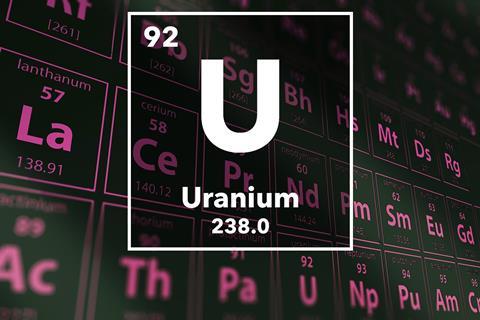
Uranium sits amongst the actinides, the second shell of metals to fill their f-orbitals with valence electrons, making them large and weighty.
Chemically, uranium is fascinating. Its nucleus is so full of protons and neutrons that it draws its core electron shells in close. This means relativistic effects come into play that affect the electron orbital energies. The inner core s electrons move faster, and are drawn in to the heavy nucleus, shielding it better. So the outer valence orbitals are more shielded and expanded, and can form hybrid molecular orbitals that generated arguments over the precise ordering of bonding energies in the uranyl ion until as recently as this century.
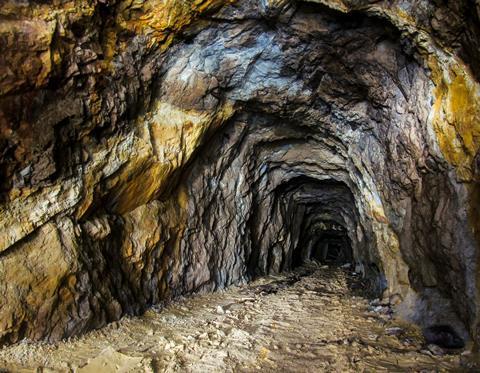
This means that a variety of orbitals can now be combined to make bonds, and from this, some very interesting compounds. In the absence of air, uranium can display a wide range of oxidation states, unlike the lanthanides just above it, and it forms many deeply coloured complexes in its lower oxidation states. The uranium tetrachloride that Péligot reduced is a beautiful grass-green colour, while the triiodide is midnight-blue. Because of this, some regard it as a 'big transition metal'. Most of these compounds are hard to make and characterise as they react so quickly with air and water, but there is still scope for big breakthroughs in this area of chemistry.
The ramifications of relativistic effects on the energies of the bonding electrons has generated much excitement for us synthetic chemists, but unfortunately many headaches for experimental and computational chemists who are trying to understand how better to deal with our nuclear waste legacy.
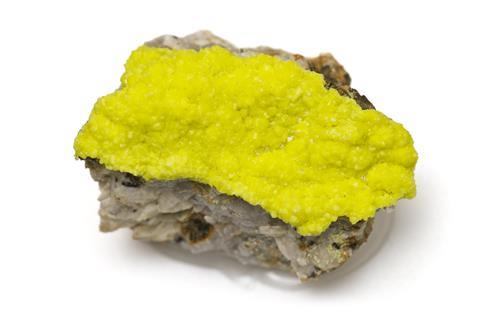
In the environment, uranium invariably exists as a dioxide salt called the uranyl ion, in which it is tightly sandwiched between two oxygen atoms, in its highest oxidation state. Uranyl salts are notoriously unreactive at the oxygen atoms, and about half of all known uranium compounds contain this dioxo motif. One of the most interesting facets of this area of uranium chemistry has emerged in the last couple of years: a few research groups have found ways to stabilise the singly reduced uranyl ion, a fragment which was traditionally regarded as too unstable to isolate. This ion is now beginning to show reactivity at its oxygen atoms, and may be able to teach us much about uranium's more radioactive and more reactive man-made sisters, neptunium and plutonium – these are also present in nuclear waste, but difficult to work with in greater than milligram quantities.
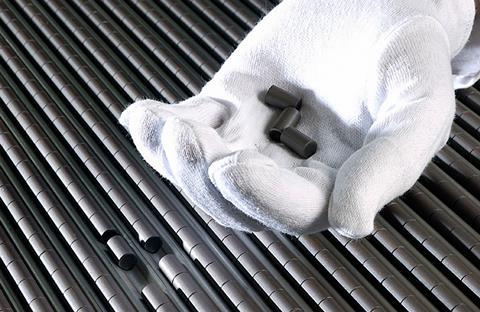
Outside the chemistry lab, uranium is best known for its role as a nuclear fuel. It has been at the forefront of many chemists' consciousness over recent months due to the international debate on the role that nuclear power can play in a future as a low-carbon energy source, and whether our new generations of safer and efficient power stations are human-proof.
To make the fuel that is used to power reactors to generate electricity, naturally occurring uranium, which is almost all U-238, is enriched with the isotope U-235 which is normally only present in about 0.7 %. The leftovers, called depleted uranium, or DU, have a much-reduced U-235 content of only about 0.2 %. This is 40% less radioactive than natural uranium, and the material that we use to make compounds from in the lab.
Because it is so dense, DU is also used in shielding, in the keels of boats and more controversially, in the noses of armour-piercing weapons. The metal has the desirable ability to self-sharpen as it pierces a target, rather than mushrooming upon impact the way conventional tungsten carbide tipped weapons do.
Critics of DU weaponry claim it can accumulate around battlefields. Because uranium is primarily an alpha-emitter, its radioactivity only really becomes a problem if it gets inside the body, where it can accumulate in the kidneys, causing damage. However, uranium is also a heavy metal, and its chemical toxicity is of greater importance – it is approximately as toxic as lead or mercury.
But uranium doesn't deserve it's image as one of the periodic table's nasties. Much of the internal heat of the Earth is considered to be due to the decay of natural uranium and thorium deposits. Perhaps those looking to improve the public image of nuclear power should demand the relabelling of geothermal ground-source heat pumps as nuclear?
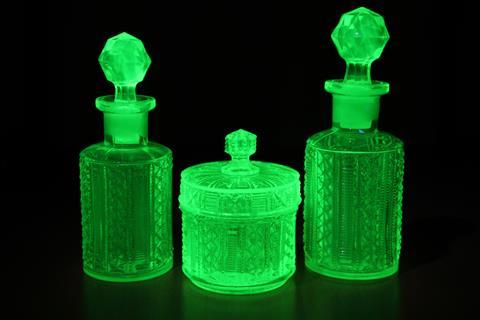
The reputation of this element would also be significantly better if only uranium glass was the element's most publicly known face. In the same way that lead salts are added to glass to make sparkling crystal glassware, uranyl salts give a very beautiful and translucent yellow-green colour to glass, although glassmakers have experimented to produce a wide range of gem-like colours. An archaeological dig near Naples in 1912 unearthed a small green mosaic tile dated back to 79 AD, which was reported to contain uranium, but these claims have not been verified. However in the early 19th and early 20th century it was used widely in containers and wine glasses. If you think that you own a piece, you can check with a Geiger counter, or by looking for the characteristic green fluorescence of the uranium when held under a UV-lamp. Pieces are generally regarded as safe to drink from, but you are advised not to drill holes in them, or wear them. Fair enough.
Chris Smith
Or inadvertently eating it too, presumably. That was Edinburgh University chemist Polly Arnold explaining the softer side of the armour piercing element Uranium. Next week Andrea Sella will be introducing us to some crystals with intriguing properties.
Andrea Sella
'It's amazing stuff. You HAVE to see this.' He pulled out of his pocket a sample vial containing some stunning pink crystals that glinted alluringly. 'Wow!' I said – you can always impress a chemist with nice crystalline products. 'It gets better.' he said mysteriously. He beckoned me into a hallway. 'Look' he said. As the crystals caught the light from the new fluorescent lights hanging from the ceiling, the pink colour seemed to deepen and brighten up. 'Wow!' I said again. We moved the crystals back into the sunlight and the colour faded again, and moving the crystals back and forth they glowed and dimmed in magical fashion.
Chris Smith
But what did they contain? Well, the answer's erbium and you can hear all about it in next week's Chemistry in its element. I'm Chris Smith, thank you for listening and goodbye.













No comments yet